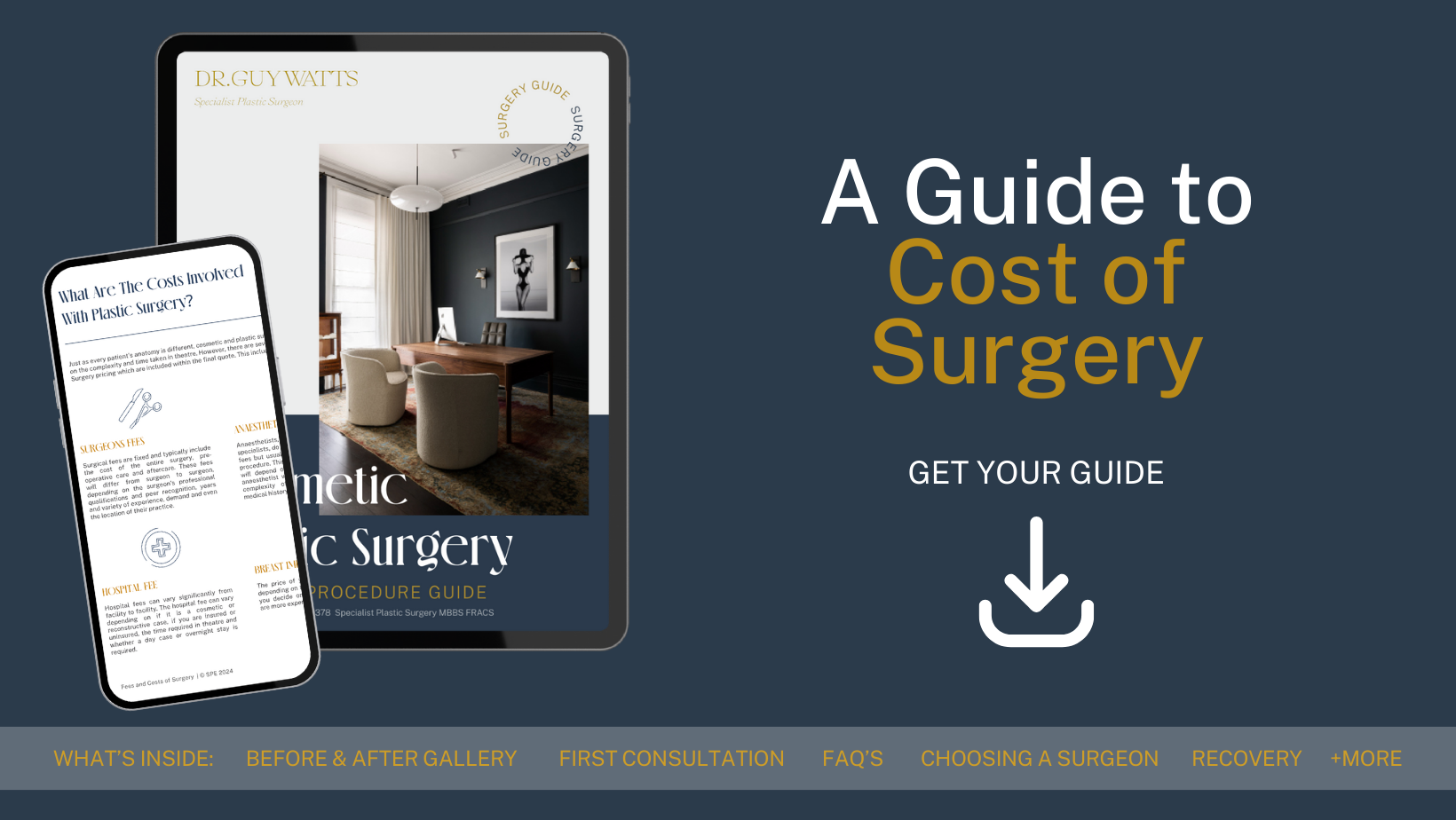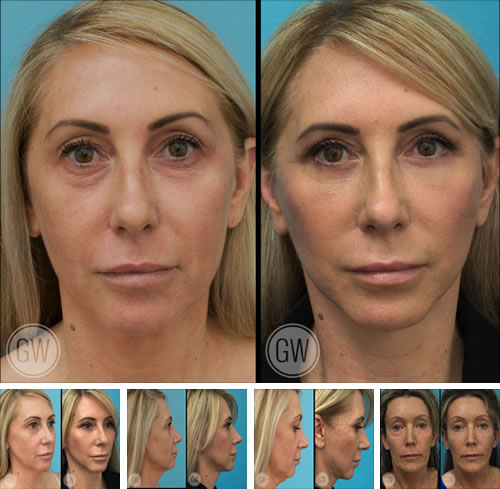This website contains imagery which is only suitable for audiences 18+.

Face Lift
WHAT IS A FACELIFT?
A Facelift, medically known as Rhytidectomy, is a surgical procedure designed to reduce visible signs of ageing in the face and neck. The primary goal of a Facelift is to alter the facial appearance by reshaping and lifting the lower half of the face. This is achieved by removing excess skin, tightening underlying tissues, and re-draping the skin on the face and neck. A Facelift may address a range of concerns including skin ptosis (excess skin), deep creases around the mouth and nose, jowls and the appearance of a double chin caused by excess skin and excess fatty deposits.
Facelift surgery is customised to each individual’s needs and desired outcome and it can be performed alone or in conjunction with other procedures such as a Brow Lift or Eyelid surgery to optimise the results.
TYPES OF FACELIFT SURGERY
Facelift surgery can be categorised into several types, each targeting specific areas of the face and varying in complexity and invasiveness:
- Traditional Full Facelift: This comprehensive approach addresses significant signs of ageing across the face and neck. It involves incisions made along the hairline, continuing around the ears and possibly extending into the lower scalp. A Full Facelift may be suitable for patients with extensive skin ptosis and laxity.
- Mid-Facelift: Focusing on the middle of the face, this technique targets the area around the cheeks and eyes. It may be suitable for those that desire increased cheekbone contour and freshen up the lower eyelid area.
- Partial-Facelift: Also known as a “short scar” Facelift, this option may be suitable for individuals with mild to moderate skin laxity. The incisions are shorter than other Facelift techniques and often limited to the hairline around the ears. A Partial Facelift offers more limited results and less recovery time and may be suitable for patients that require less significant changes.
- SMAS (Superficial Musculoaponeurotic System) Lift: This method involves repositioning and tightening the underlying layer of muscles (SMAS) along with the removal or redistribution of facial fat. It’s particularly effective for alleviating skin ptosis and increasing facial contours.
- Deep Plane Facelift: A more extensive procedure, the Deep Plane Facelift goes deeper than the SMAS lift, repositioning the whole facial musculature. This type of Facelift can achieve more significant and long-lasting results, especially in the mid-face and neck areas.
- Thread Lift: While not a Traditional Facelift, a Thread Lift is a procedure where temporary sutures are used to produce a subtle but visible “lift” in the skin. It’s less effective in terms of results and longevity compared to other types of Facelifts but involves fewer risk and recovery time.
Each type of Facelift has its indications, potential benefits, and limitations. Dr. Guy Watts and his team can provide a comprehensive assessment to determine the most suitable type of Facelift surgery based on the individual’s facial structure, skin condition, and aesthetic goals.
DOWNLOAD YOUR FREE GUIDE TO FACE AND NECK LIFT SURGERY

WHO IS A GOOD CANDIDATE FOR FACELIFT SURGERY?
Good candidates for Facelift surgery are typically individuals who are looking to address signs of ageing in the face and neck. Key factors that typically make someone a suitable candidate include:
- Skin Laxity: The presence of excess skin in the face and neck is a primary concern that a Facelift may help address.
- Overall Health: Candidates should be in good general health, without any medical conditions that impair healing or increase the risk of surgery.
- Non-smokers: Smoking can significantly affect the healing process, so non-smokers or those who can cease smoking well in advance of surgery and throughout the recovery period are ideal candidates.
- Realistic Expectations: It’s important for candidates to have a clear understanding of what Facelift surgery can and cannot achieve. A positive outlook and specific, but realistic goals are crucial.
- Age Factors: While there is no ideal age for a Facelift, most candidates are typically in their 40s to 70s. However, suitability is more about the specific signs of ageing and overall health than physical age.
During the initial consultation, Dr. Guy Watts will assess these factors, discuss the individual’s aesthetic goals, and determine whether a Facelift is the most appropriate course of action.
WHAT CAN FACELIFT SURGERY DO FOR ME
- Reduces visible signs of ageing
- Removes excess skin
- Tighten remaining skin
- Alter facial contours
- Reduce the appearance of fine lines and wrinkles
REQUEST AN APPOINTMENT
HOW IS THE SURGERY PERFORMED?
Facelift surgery is performed under general anaesthesia and can take several hours, depending on the extent of the procedure. The steps generally include:
- Incisions: The location and length of the incisions depend on the type of Facelift being performed. Generally, incisions are made in the hairline at the temples, continuing around the ear and ending in the lower scalp. For a Neck Lift, incisions may be made under the chin
- Repositioning and Tightening: After making the incisions, the skin is lifted, and the underlying tissue and muscles are repositioned and tightened. In some cases, deeper layers of the face and the muscles are also lifted.
- Removing Excess Skin: Excess skin is trimmed away, and the remaining skin is re-draped over the new contours.
- Closing the Incisions: The incisions are closed with sutures or skin adhesives. Care is taken to make sure the scars are concealed within the hairline and contours of the face.
- Recovery: After the surgery, you will be taken into a recovery area where your progress will be monitored.
Dr. Guy Watts and his team use advanced techniques and attention to detail to optimise results while prioritising patient safety and comfort. The specific techniques used will be tailored to the individual’s unique facial structure and aesthetic goals.
RECOVERY AFTER FACELIFT SURGERY
Recovery from Facelift surgery varies among individuals, but there are general guidelines that most patients can expect to follow:
- Immediate Post-Operative Period: After the surgery, it’s common to experience swelling, bruising, and discomfort. Dr. Watts may place bandages around your face to reduce swelling and bruising. A small tube might also be present to drain any excess blood or fluid.
- First Week: During the first week, patients are advised to rest and keep their head elevated. Any prescribed pain medication should be taken as directed to manage discomfort. Most patients can expect to have their sutures and drainage tubes removed within a week after surgery.
- Following Weeks: Swelling and bruising will gradually diminish over the next few weeks. Most patients can return to work and light activities within two weeks, but strenuous activities should be avoided for at least four to six weeks.
- Long-term Care: It’s crucial to follow Dr. Watts’ instructions on wound care, sun protection, and lifestyle to optimise recovery and results. The final results of a Facelift become apparent after several months.
Dr. Watts and his team provide comprehensive post-operative care instructions and are available to answer any questions or concerns during the recovery period.
DOWNLOAD DR WATTS’ GUIDE TO COST OF SURGERY

FAQS ABOUT FACELIFT SURGERY
How long do the results of a facelift last?
The results of a Facelift can last for many years. While the procedure can pause or even alter some of the signs of ageing for a little while, it doesn’t stop the ageing process. Factors such as skin health, lifestyle, and genetics play a role in the longevity of the results. On average, patients can expect the results to last for about 10 years.
What is the right age for a facelift?
There is no “right” age for a Facelift. The timing depends on individual factors such as skin condition, degree of facial ageing, and personal goals. Facelifts can be effectively performed on patients in their 40s to 70s and beyond.
How should I prepare for facelift surgery?
Preparation involves several steps, including avoiding certain medications that can increase bleeding, stopping smoking, arranging for help during the recovery period, and following specific instructions provided by Dr. Watts regarding diet and medications.
What are the risks of Facelift Surgery?
As with any surgical procedure, Facelift surgery carries certain risks and potential complications. Dr. Watts informs all patients about these risks, which may include:
- Anaesthesia Risks: As with any procedure involving anaesthesia, there are risks such as allergic reactions and respiratory issues.
- Bleeding and Infection: There is a risk of bleeding and infection, although these are relatively rare in Facelift surgery.
- Scarring: Incisions are made to reduce visible scarring, but the visibility of scarring can vary depending on individual healing processes.
- Nerve Injury: There is a small risk of nerve injury, which can lead to muscle weakness or facial asymmetry. This is typically temporary, however in some rare cases it can be permanent.
- Skin Irregularities: Changes in skin sensation, contour irregularities, or skin discolouration may occur.
- Prolonged Swelling and Bruising: Some patients may experience prolonged swelling and bruising, but these typically resolve with time.
Dr. Watts prioritises patient safety and takes every precaution to reduce them. It’s important for patients to disclose their full medical history and follow all pre- and post-operative instructions to reduce the likelihood of complications.
Medical References for Facelift Surgery
- Facelift: What You Should Know – American Society of Plastic Surgeons
- Facelift – Mayo Clinic
- Rhytidectomy – MedlinePlus
- Facelift Guide – The American Board of Cosmetic Surgery
- What to Know About Liquid Facelifts – WebMD
Next Steps on Your Plastic Surgery Journey
PLEASE TAKE INTO CONSIDERATION
| Any surgical or invasive procedure carries risks. Before proceeding, you should seek a second opinion from an appropriately qualified health practitioner. |
About Dr. Guy Watts – MED0001539378
FRACS (Plas) – Specialist Plastic Surgeon In Perth WA
Dr. Guy Watts is a Specialist Plastic Surgeon (AHPRA MED0001539378) with an extensive career that spans across renowned plastic surgery clinics worldwide. His experience has been honed through invaluable experiences at esteemed establishments such as the New York Eye and Ear Infirmary and the renowned Pitanguy Clinic in Brazil.
Having collaborated with the foremost cosmetic plastic surgeons on a global scale, Dr. Watts has chosen to return to Perth after a 17-year journey of intensive training and invaluable professional experience to bring the latest practices and technology in cosmetic plastic surgery to his patients.
Dr. Watts is a Fellow of the Royal Australasian College of Surgeons (FRACS) and a Member of the Australian Society of Plastic Surgeons (ASPS), Australasian Society of Aesthetic Plastic Surgeons (ASAPS) and the International Society of Aesthetic Plastic Surgeons (ISAPS).
Read about the potential Risks and Complications of Surgery
Read the Patient Information and Resources
About CLINISPA
Clinispa is Dr Watts’ bespoke medical clinic performing Cosmetic Aesthetic treatments. At Clinispa, we offer advanced clinical treatments in a luxurious and calming environment, tailored to support your skin’s health and appearance.
Clinispa aesthetic services are performed by Dr Guy Watts’ nursing professionals, who have a passion for and solid understanding of facial aesthetics.
All Clinispa clients are considered individually, with a personalised treatment plan consisting of advanced scientific approaches to cosmetic aesthetics. We incorporate innovative technologies in conjunction with superiorly formulated skin care.
For more information about the full range of Clinispa Aesthetic of Cosmetic Treatments visit the Clinispa website









